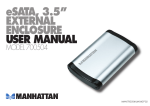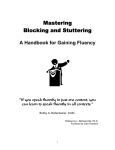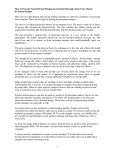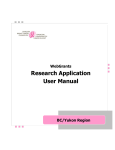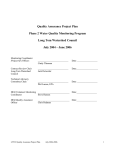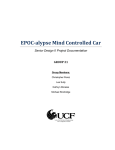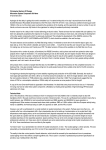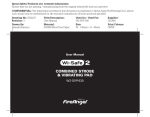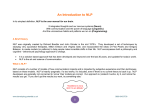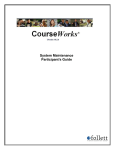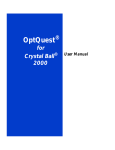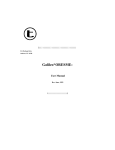Download The Power of NLP
Transcript
The Power of NLP Sandra Westland Contents Page 1) What is NLP? 3 2) NLP Attitudes and Behaviour 4 3) NLP Presuppositions 5 4) Learning 8 5) Outcome Thinking 9 6) Representational Systems 10 7) Submodalities 12 8) NLP in Basic Practice 15 NLP Practitioner Training 20 References 22 2 The Power of NLP Sandra Westland Introduction This eBook is a very brief introduction to Neuro-Linguistic Programming, a model that underpins “Smashing the Glass Ceiling: The Ultimate Women’s Guide to Business Success”. I hope you find it an informative read. 1. What is NLP? “NLP is one of the most powerful models of change ever invented which aimed, and succeeded, in discovering how to model incredibly successful people to show that if one person could do something amazing, then another could follow their strategies for success, to achieve the same. It teaches people how to learn, communicate and motivate themselves and others, and how to change behaviour. The goal in all of this is about striving for excellence.” (Westland, 2013) Here are some further quotes as to what NLP is: “NLP is the art and science of excellence, derived from studying how top people in different fields obtain their outstanding results….. NLP is a model of how individuals structure their unique experiences of life … NLP represents an attitude of mind and a way of being in the world … NLP is practical. It is a set of models, skills and techniques for thinking and acting effectively in the world. The purpose of NLP is to be useful, to increase choice and to enhance the quality of life.” (’Connor and Seymour xii, 1990) “NLP offers a model for learning how to recognise excellence and how to emulate it … the NLP model instructs us how to achieve excellence… Taking control of our own minds describes the heart of NLP” (xii – xvii) (Bodenhammer and Hall, 2002) “NLP is the study of excellence. It is an attitude of learning, curiosity and respect for unique ways of being in the world … NLP is a process of modelling the conscious and unconscious patterns that are unique to each of us in such a way that we are continuously moving towards a higher potential” (Knight, 2013) A famous quote from one of the founders of NLP is … “NLP is an attitude and a methodology that leaves behind a trail of techniques” - Richard Bandler. The attitude of NLP involves exciting the mind and leading it on a search to know what goes on behind the scenes. The attitude of NLP involves experimentation. Trying things out. 3 The Power of NLP Sandra Westland The Methodology of NLP involves modelling. Modelling what we know works from experts. “Neuro-Linguistic Programming” brings together 3 areas: Neurology – Refers to our brain and our physiology. The mind and how we think. How it processes information and codes it as memory inside our body/neurology. Linguistics – How we use language to communicate with ourselves and others, and how it affects us. It is crucial to understand the structure of our language. Your words are your life, it tells your story. Programming – How we sequence and order these parts in our actions to achieve our goals. The programmes we run inside our brain. 2) NLP attitudes about Behaviour Our beliefs act as our filters, causing us to behave in a certain manner and to interpret things in a certain way rather than in another way. NLP offers a specific way of thinking about ourselves, the world and others. It is a model, so it is not stating truths, just possibilities and invites you to experiment with certain behaviours “as if” they were true to see the difference it makes for you. Here are 5 basic attitudes that NLP asks us to try on for size … 1. Outcome rather than problem If you focus on the problem, you are focusing on what is wrong and what is in need of fixing. This likely makes us feel bad and un-resourceful, making the situation harder to solve. If you ask question like … What is wrong? How long has it gone on for? When did it start? Whose fault is it? Why haven’t you solved it yet? It doesn’t feel too good! If you ask … What do you want? What resources do you have? How can you use your resources to reach your goal? There is a completely different feel to things. 2. How rather than why “Why do I have this problem?” doesn’t lead us anywhere in NLP. What we need is to understand the structure of what is happening. In understanding the detail of how something is occurring, e.g. a panic attack, we can understand better the process that is gone through that creates the outcome (the panic attack). If the outcome isn’t working, we can use techniques to alter the process to get to a better one (no panic attacks). 4 The Power of NLP Sandra Westland 3. Feedback V’s Failure There is no such thing as failure, only results. Feedback keeps the goal in sight. As long as we are doing something differently, or simply out there in life living it, we keep gaining further information about how we work and how we can get to the outcome we want. If we see things that don’t work in the way we wanted it too as failure, it becomes much more personal. “I failed to get that job” stops there! “I wasn’t as natural as I would have liked to have been at the interview” gives us something to work on and change. 4. Possibilities rather than Necessities Look at what you can do and what choices are available rather than constraints in the situation. “I didn’t get that job, that’s the holiday on hold and I am now stuck where I am for a while.” Or “I didn’t get that job, which gives me time to check out what I really want to do, to become more confident in myself in a non pressured situation as I know this job and the people I work with like the back of my hand.” 5. Curiosity and Fascination In having curiosity, we are open to understanding more of what is happening and are creating expectancy for change. 3) NLP Presuppositions “Amongst the many facets of human behaviour it “unpacks,” NLP offers a number of principles to live and work by. They are called pre-suppositions, as they presuppose something to be true in the way human beings operate, which have been gleaned through the study of behavioural excellence. They are a set of assumptions that can guide you to successful and positive outcomes in your life should you wish to adopt them.” Westland 2013 Here are some of the NLP presuppositions: 1) If you always do what you have always done, you will always get what you always got. We are each responsible for our own lives. If we always act/respond in the same way, then the most likely result is that nothing at all will change. If you ask your boss for a pay rise and he says no, then if you always ask him in that same way, you will likely always get that same answer. So if you find yourself saying "that's the way we've always done it" … challenge yourself! 5 The Power of NLP Sandra Westland 2) The map is not the territory. Words are not the things they describe; symbols are not the things they represent. We are always slightly separated from 'reality'. We draw maps, but the map is not actually the place it depicts and we need to be responsive to what is actually happening around us. People respond to their map or interpretation of reality, not to reality itself. NLP is about understanding and changing maps, which in turn can change perceptions of reality. 3) You cannot not communicate. People often imagine that they can avoid personal responsibility by simply saying nothing. This pre-supposition points out that we are constantly communicating, by what we do say, by what we don't say, and by a host of non-verbal signals. 4) The meaning of your communication is the response that you get. People will respond to what they think you mean, which may be an accurate or inaccurate interpretation of your intended meaning. Communication creates an experience in the listener or reader. The result is the response we elicit. If we want people to respond appropriately to what we say then we need to talk to them rather than at them. 5) There is no such thing as failure, only feedback. Everything is a learning opportunity to find out what works and what doesn't work. It is important to separate behaviour from identity. Edison identified about a 1,000 materials which are not suitable as filaments for a light bulb before he found one which worked and worked well. 6) If you want something different you must do something different, and keep varying your behaviour until you get the result that you want. There's a solution to every situation if you're prepared to keep looking until you find it. 6 The Power of NLP Sandra Westland 7) Every behaviour has a positive intention. This is possibly the most controversial of the NLP presuppositions, since it is so open to misinterpretation. What this actually means is that every behaviour has a positive intention, as far as the person exhibiting the behaviour is concerned. This does not mean that the behaviour is the best possible choice (from an objective point of view). Nor does it mean that the behaviour will have positive benefits for anyone else. When we are changing unwanted behaviours or habits, and moving toward healing, it is necessary to find the deep structure or original intention behind the behaviour. We can then create new and better choices that preserve the positive intention. 8) Every behaviour is appropriate in some context. If we adopt a certain behaviour it's because once upon a time it worked. The trouble is that we often go on doing a certain behaviour even though it is manifestly no longer appropriate. 9) People always make the best choice available to them at the time. Often there are better choices. NLP discovers more effective choices and how to create more useful or desirable actions and beliefs. 10) If one person can do something, other people can learn from that person's success. NLP models excellence. It is possible to discover the components and strategies needed to achieve particular results and to teach it to someone else. 11) Everyone has all of the resources they need. We all already are likely to have all the resources we need to be able to deal with the "presenting problem". NLP teaches how to access these resources at appropriate times and places. 12) The person with the greatest number of choices in a given situation is likely to get the best outcome for themselves. 7 The Power of NLP Sandra Westland If we can only work with one specific outcome and we are inflexible with this, then it will be limiting us should things not go to the exact plan. 13) Genuine Understanding only comes from Experience. You can read all you like, and talk to as many other people as you like, and you can watch other people doing something on video, but you don't really understand something until you personally have done it. 14) Your mind and your body are parts of the same system. Your mind and body are connected. 4) Learning Our conscious mind is limited to the amount of information that it can manage, but our unconscious holds all the life giving processes of our body (that make our heart beat, that monitors our body and mends broken bones etc.) and all that we have learned and all our past experiences. It is incredible when you think about it. The notion of conscious and unconscious is central to the NLP model of how we learn. Conscious is what we are aware of in this very moment. Unconscious is what is not present in our awareness at any particular time. In NLP Learning there are 4 stages: 1) Unconscious incompetence – You don’t know how to do something and you don’t know what you don’t know. Never having ridden a horse, you have no idea what that will be like or what you need to know. 8 The Power of NLP Sandra Westland 2) Conscious incompetence – You start to learn to ride. You have some lessons and consciously attend to all the different aspects of riding. It demands all your attention and things feel stiff, with a lot of self talk about what you need to be doing and when you need to be doing it. 3) Conscious competence – You can ride, but it takes all your concentration. You have learned the skill of riding a horse, but not yet mastered it. 4) Unconscious incompetence – All the different parts of the skills you need all blend into one. You can enjoy the scenery, chat to someone who is riding with you, as your unconscious mind can carry out the skills without you consciously attending to them. If we practice something long enough, we enter the 4th stage and it becomes a habit. If the habit is no longer getting you the outcome you want, then things need to be broken down into parts again and put back together, starting with the conscious incompetence – an unlearning to then relearn. 5) Outcome Thinking To live the life you want, you first need to know what you want. The fuller the idea of what you want, the more you mentally rehearse it, the more then your neurology can establish pathways for it and recognise opportunities to achieve it. So this has to be a sensory based notion you hold; seeing, hearing, feeling, thinking what outcome that you want. In NLP terms, you choose a Well Formed Outcome. An outcome that is well formed through the following criteria. 9 The Power of NLP Sandra Westland Outcomes need to be: a) Positive – What do I want (not what don’t I want)? b) Owned - What will I be doing to achieve my outcome? c) Specific – Who, where, when, what, how specifically? d) Evidenced – What will I see, hear, feel, think when I have it? How will I know when I have it? e) Resourced – What resources do I need to get the outcome? Have I got those resources? If not, how can I get them? f) Positioned – Is it big enough to motivate me? What will I gain and where will I go once I have achieved the outcome? g) Ecologically Sound – Does it fit with my sense of self? Who else will this effect? What would happen if I got it? If the outcome is well-formed, it is achievable, motivating and much more likely to be compelling. 6) The Representational System – Modalities “All of your experiences result as a product of what we see, hear, feel, touch and smell. In NLP we refer to these senses as the representational system.” Bodenhammer and Hall (2002) We see, hear, touch, smell and taste the outside world. We then recreate those same sensations within our minds (our internal world). We re-present the world to ourselves. We use this representational system in everything we do, storing memories, planning, imagining the future and problem solving. The main systems are as follows: Kinaesthetic, visual, auditory, olfactory and gustatory 10 The Power of NLP Sandra Westland The Kinaesthetic System: This is touch, bodily awareness and emotions. The Visual System: This is how we create internal pictures, visualise, daydream, imagine. The Auditory System: This is how we listen to things, talk to ourselves and rehear the voices of other people. The Olfactory System: This consists of created and remembered smells. The Gustatory System: This consists of created and remembered tastes. We do not use one representational system in isolation. Thinking is a mix of all the systems although one system will tend to be more developed than others. There is no right way of thinking and it is important to know which system the person you are communicating with prefers, so that we can “speak their language.” Do you “See what I mean?” or “Hear what I am saying?” or “Have a feel of it all? “Think about what I am saying here!” Begin now to think about how you “chain” a sequence of representation systems in different situations. For example, when I meet someone (I am “auditory” primarily), I first hone in on their voice, the tone, the pitch and the pace of the conversation. This will tell me where I sense that 11 The Power of NLP Sandra Westland person is at. This will then produce a feeling (kinaesthetic modality). What they will look like will be the last thing that I will notice (if I do at all). I remember a friend taking me to help her choose a cot in preparation for the birth of her son. We went to 2 different shops and saw 2 that she was interested in. By the time I had got to the second shop and she asked me which one I preferred, I had to confess that I could not remember what the first one looked like! I had no image of it in my mind. Her, being very visual remembered the other cot in great detail. I don’t think I was much help, but we laughed when we realised just how differently we operate. 7) Submodalities These are the qualities of the representational systems. They “comprise the building blocks of the representational system” Bodenhamer and Hall (2002). For example: The quality of a visual image in your mind, will be about brightness, colour (or black and white), or if it is framed in your mind or panoramic etc. The quality of sounds will be about the particular tone, pitch, rhythm etc. The quality of feelings will be about the type of texture or a temperature etc. Submodalities code our experiences of reality and time, and are the core component of our experiences. If we change the structure (submodalities) of an experience, we can change the meaning. We cannot change what has happened, but we can change how we internally represent and perceive a memory. 12 The Power of NLP Sandra Westland For example: Jane had a bad experience at an interview about a year ago. Now any interview she goes to brings forward this past experience with all the thoughts and feelings that go with it. How can submodalities help her? We can break down how the memory is being held in her mind, so it no longer is so potent and the meaning is simply “it was an interview”. This means we have to change the submodalities. When we break down how Jane holds this memory, we notice that it is held (coded) in bright colours, all around Jane (associated), and with the “official” tone of the interviewer prominent. What we can do here is make some changes and thus change the meaning. So for example, we could change the image to black and white and get her to step out of the memory (dissociated) so they are watching themselves. We can also turn down the sound of voices. This will alter the meaning to more of a “non plus”, ambivalent meaning. Also, in exploring submodalities in an experience it can really help the person find out so much more about themselves. The finer the detail, the more clearly and creatively we can think. Imagine really knowing just how we hold “confident” and “uncertain” states. We can then know how to create the confidence when ever we choose as well as recognising an uncertain state much quicker. This is learning about the “critical submodalities”, those that increase the impact. Example of Submodalities: Recall a very relaxing time and create an image. Notice if it is …. 13 The Power of NLP Sandra Westland Visual: Black and White or colour? Near or Far? Bright or Dim? Large or Small Picture? Associated or Dissociated? Focused or Defocused? Framed or Panoramic? Movie or Still? 3d or Flat? Auditory: Location Direction Internal or External Loud or Soft Fast or Slow High or Low Tonality Duration Kinaesthetic: Location Size Shape Intensity Steady Vibration Weight If you were to do the same for an event that created anxiety, notice the difference in how you code the image. If you know how you code relaxation then you can use this code to re-code anxiety, thus changing the perception/experience of it. So if relaxation was in a frame and anxiety is panoramic. You can mentally put the anxiety image in a frame and notice how different it all becomes. To read more about “mapping across” in NLP, you can go to “The Book on Back Pain: The Ultimate Guide to Permanent Relief” by Tom Barber. 14 The Power of NLP Sandra Westland 8) NLP in Basic Practice A “state” is our way of being in any moment in time. It is made up of physiology, thinking and emotions. It is our “internal experience”. The sum total of all neurological and physical processes within an individual at any moment in time. They vary in intensity, length and familiarity. The calmer the state the easier it is to think clearly and rationally. States affect our capabilities. When we get into an un-resourceful state (perhaps an angry state say) our resources seem less available to us. For example someone may have thoroughly prepared for an interview, or be a very competent learner driver, but actually in the interview or the driving test, that person does not perform very well, because they go into an “exam state” perhaps. How well you learn and how well you perform depends on the state that you are in. “There are no un-resourceful people, only un-resourceful states.” What ever outcome that you want, there is the question “What state do I want to be in to make this happen easily?” An “anchor” is any stimulus that evokes a response, anything that accesses an emotional state. They can occur naturally or can be set up intentionally. They are created by repetition or they can also be created by a single experience if the emotions are strong enough. Being bitten once by a dog can create an anchor. By this I mean that seeing any dog can evoke a panic reaction. 15 The Power of NLP Sandra Westland Anchoring is the process by which any stimulus gets connected to, and so triggers, a response. The concept of anchoring derives from the Pavlovian stimulus-response reaction, classical conditioning. In Pavlov’s study the sounds of the bell became the stimulus (anchor) that cued the dog to salivate. For example, some anchors may be: Finishing meal (stimulus) – lighting up a cigarette (response) A song (stimulus) – feelings of sadness or happiness (response) The sound of a siren (stimulus) – hitting the breaks in a car or looking at the speed you are doing! (response) Seeing a spider (stimulus) – panic attack (response) How to Change States We are looking to be able to have emotional freedom which means to have the ability to change the state and choose how we feel. This is useful when: public speaking taking a test dealing with stressful situations making a difficult decisions To resource someone in the situation you need to : 1. Elicit a resourced state – This means to ‘get into’ a state that is empowering for the individual. To help do this, you need to access the state that is required. This needs describing /exploring and then you can bring forward a time in the past when you were in 16 The Power of NLP Sandra Westland the state you want to be in. Then go into this memory and see it though your own eyes, really be in it (being associated). Elicitation is a word used in NLP to describe the process of guiding someone into a particular state. 2. Calibrate the state – this is where we need to know in as much detail as possible what this state looks like and sounds like. A sensory specific description is needed, what is seen, heard and felt. This calibrates the state so that you can recognise it again. Calibration is the NLP word that means recognising when people are in different states. This is being able to distinguish the subtle different expressions as others experience differing states. 3. Anchoring the state – You can anchor a resourceful state visually, auditory or kinaesthetic. Eg. A hand gesture could be a visual anchor, or a word could be an auditory anchor and a touch could be a kinaesthetic gesture. When a state has been anchored it means when the hand gesture, word or touch is made in the future, it will automatically produce the resourceful internal state. So I could say the word “calm” to myself, or clench my fist and relate this to the same feelings I had on a relaxing holiday. The anchor should be unique and repeatable. It would be ineffective if you used say, a hand shake as an anchor. Handshakes are very common and are already linked to many different feelings and situations. When we anchor a positive state, you really need to be right at the peak of the experience. So when I am fully in the experience of calmness, then the anchor is created. That way I can, as 17 The Power of NLP Sandra Westland and when I need, recreate these desired feelings, by firing the anchor (saying the word “calm” say). 4. Test the anchor – check how you feel when you apply the anchor. It takes up to 20 times for the anchor to become dependable. 5. Future pacing - Ask the person to imagine the stressful situation where they want to use the resource anchor and to imagine using the anchor. Ask them to set something that will remind them to use the anchor. E.g. A postman, who sees an NLP Practitioner for smoking cessation, could have an anchor set of say the colour “red”. We could anchor in calm, positive, determined feelings to the colour red. So as he notices red around him (post boxes?), his brain has been programmed to elicit the calm, positive, determined state! For a further explanation on anchoring please refer to Smashing The Glass Ceiling, Chapter 8. There is so much more to learn about NLP, and so much it can be and do for anyone who embraces it. But this was a very brief introduction to the basics and so I hope you have a feel of just what it can do for you. I hope you continue reading about NLP and doing some training in it, as it is only in doing and being NLP can you recognise its potential. In summary … 1) NLP is the study of our subjective experience. “By discovering how we structure our memories, our imagination and our thoughts, we can find out how we are making our work and our life exactly what they are.” (Knight 2013) Then we can re-programme ourselves when we are not getting the outcome that we want so that we can make new choices. 2) NLP helps you find your own unique excellence. 18 The Power of NLP Sandra Westland 3) NLP enables you to manage yourself to achieve what you want. 4) NLP helps you learn the ability to learn from every experience in life to achieve empowerment. I hope you have found this eBook helpful. On the next page you can find out more about how you can deepen your knowledge of NLP even further. 19 The Power of NLP Sandra Westland Neuro-Linguistic Programming 12 Day Practitioner Course (AUNLP Certified) This Neuro-Linguistic Programming course will teach you: How to be a practitioner and how to work with clients. Once you have completed and passed this NLP course you will be able to gain insurance to practice. How to work with: Confidence building Weight loss Anxiety and Panic Phobias Smoking Cessation Habits How to work safely and ethically, being aware when referral is necessary. How NLP works in teaching, with children and in business. What you will learn on this course: The Presuppositions of NLP - The basic beliefs and assumptions that underpin success. Well Formed Outcomes: The framework of questions which ensures ecological, desirable and attainable goals and objectives. State Management - The ability of an individual to monitor and have influence on their emotional responses to situations. 20 The Power of NLP Sandra Westland Rapport - The ability to establish and maintain a level of relationship sufficient to achieve desired outcomes. Sensory Acuity - The ability to notice the subtle changes in behaviour that indicate internal changes in another person. Calibration - The ability to notice patterns in behaviour so that changes in intensity can be detected and interpreted. Our Representational Systems - The neurological mechanisms behind the five senses which indicate preferred methods of gathering and processing information. Perceptual Positions - The different perspectives from which a situation can be viewed to gain more information. The Meta Model - A language model that enables the deeper structure of experience to become more apparent. The Milton Model - A model of the influential language patterns used by Milton Erickson to induce an altered trance state. Anchors - The conscious use of stimulus response patterns to affect shifts in experience. Sub-modalities - The ability to notice and adjust the inherent qualities of internal representations. Strategies - The internal sequences of behaviour that are habitually used to achieve an outcome. Frames - The use of setting boundaries on contexts to transmit, make and alter meaning. 21 The Power of NLP Sandra Westland References Bodenhamer, B. and Hall, M. (2000) The User’s Manual for the Brain: Volume 1. Carmarthen: Crown House Publishing. Knight, S. (2009) NLP at Work: The Essence of Excellence – (3rd Ed. - People Skills for Professionals). London: Nicholas Brealey Publishing. O’Connor, J. and Seymour, J. (2003) Introducing NLP: Neuro Linguistic Programming. London: Thorsons. 22 The Power of NLP Sandra Westland TRAINING IN HYPNOTHERAPY ● PSYCHOTHERAPY ● COUNSELLING ● NLP www.ContemporaryCollege.com 23























